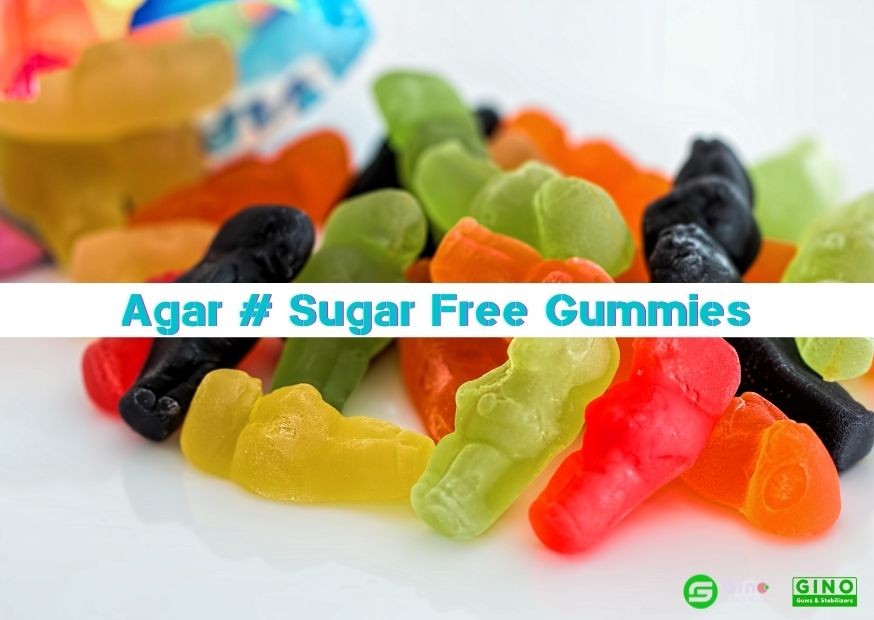An Overview of Sugar-free Gummies Recipe & Production Processes
Sugar-Free Gummies Recipe & Production

1. What is Sugar-Free Candy?
Sugar-free candy, sugarless candy is a type of candy that is made from non-sugar ingredients and processed through a series of processes.
2. What are the Benefits of Sugar-Free Candy?
It can meet people's demand for sweetness, but it can also be metabolized in the human body without the influence of insulin, and will not increase the blood sugar concentration in the human blood.
Therefore, sugar-free candy is the ideal candy for diabetic patients.
3. Types of Sugar-Free Candy
There are many types of sugar-free candy, which can be broadly divided into sugar-free hard candy, sugar-free soft candy, sugar-free chocolate, sugar-free chewing gum, etc.
Sugar-Free Hard Candy
Sugar-Free Soft Candy(Gummies)
Sugar-Free Chocolate
Sugar-Free Chewing Gum
4. Types of Sugar-Free Soft Candy (Gummies)
Gelatin Type
Agar-Agar Type
Agar/Gelatin Type
Pectin Type
5. Quality Indicators of Sugar-Free Gummies
(1) Sensory Indicators
Color and appearance: uniform color and luster, block shape is intact, no corner cracks.
Structure: soft and crisp, not sticky teeth, with good elasticity and toughness.
Taste and odor: moderate aroma, pure taste.
(2) Physical and Chemical Indicators: moisture ≤22%
(3) Health indicators in line with the provisions of GB9678.1-94
6. Sugar-Free Gummies Recipe
Ingredients Types | Gelatin Type | Agar Type | Gelatin-Agar Type | Pectin Type |
| Sorbitol % | 64.49 | 96.52 | 94.29 | 74.93 |
| Xylitol % | / | / | / | 19.80 |
| Stevia % (1% solution) | 0.50 | / | / | / |
| Gelatin Solution (1:1.5) % | 34.10 | / | 2.40 | / |
| Agar % | / | 3.57 | 2.4 | / |
| Pectin % | / | / | / | 3.96 |
| Citric Acid % | 0.40 | 0.40 | 0.40 | 0.40 |
| Trisodium Citrate % | / | / | / | 0.40 |
| Colors % | 0.01 | 0.01 | 0.01 | 0.01 |
| Flavors % | 0.50 | 0.50 | 0.50 | 0.50 |
| Total | 100 | 100 | 100 | 100 |
*Note: The number of colors and flavors added can be adjusted according to actual needs. Please feel free to contact us for extra sugar-free gummies recipe.
7. Process Flow and Critical Control Points
7. 1 Gelatin Type Sugar Free Gummies
| Dry Gelatin + Water (1:1.5) | Sorbitol (Concentration 70%) | Critical Control Point | |
| ↓ | ↓ | 1.Dry Gelatin:Water=1:1.5 2. Soaking time: 12 hours or more 3. Stewing temperature:50-60℃ 4. Sorbitol boiling temperature: 135-140℃ 5. Cooling 1 final temperature: 100-115℃ 6. Cooling 2 final temperature: 95-100℃ 7. Pouring molding temperature:80-90℃ 8. Starch mold temperature: 20-30℃, the highest cannot exceed 35℃ 9. Resting final temperature: 2-3℃ above room temperature 10.Product moisture:18-22%
| |
| Soaking | Boiling | ||
| ↓ | ↓ | ||
| Stewing | Cooling 1 | ||
| ↓ | ↓ | ||
| Gelatin Solution | → | Mixing | |
| ↓ | |||
| Cooling 2 | |||
| ↓ | |||
| Flavor, color, citric acid, stevia 1% aqueous solution | → | Mixing | |
| ↓ | |||
| Pouring and molding | |||
| ↓ | |||
| Solidification | |||
| ↓ | |||
| Demoulding, Brushing | |||
| ↓ | |||
| Placing | |||
| ↓ | |||
| Packaging |

7.2 Agar-Agar Type Sugar Free Gummies
| Agar + Water | Critical Control Point | ||
| ↓ | 1. Agar soaking time: more than 24 hours 2. Final temperature of boiling agar and sugar alcohol: 105-107℃ 3. Final temperature of cooling 1: 80-85℃ 4. Final temperature of boiling sugar alcohol: 135-140℃ 5. Final temperature of cooling 2: 80-85℃ 6. Pouring molding temperature:75-80℃ 7. Final temperature of starch mold resting: same as gelatin type 8. Product moisture: 17-21%
| ||
| Soaking | |||
| ↓ | |||
| Sorbitol (concentration 70%) | Boiling | ||
| ↓ | ↓ | ||
| Boiling | → | Filtering | |
| ↓ | ↓ | ||
| Cooling 2 | → | Cooling 1 | |
| ↓ | ↓ | ||
| Flavor, color, citric acid | → | Mixing | |
| ↓ | |||
| Pouring and molding | |||
| ↓ | |||
| Solidification | |||
| ↓ | |||
| Demolding, Brushing | |||
| ↓ | |||
| Placing | |||
| ↓ | |||
| Packaging |

7.3 Agar-Gelatin Type Sugar Free Gummies
| Agar + Water | Critical Control Point | ||||
| ↓ | 1.Gelatin:Water=1:1.5 2. Gelatin soaking time: 12 hours or more 3. Agar soaking time: more than 24 hours 4. Temperature of gelatin stewing: 50-60℃ 5. Final temperature of boiling 1: 135-140℃ 6. Final temperature of boiling 2: 105-107℃ 7. Final temperature of cooling 1: 90-95℃ 8. Final temperature of cooling 2: 90-95℃ 9. Pouring molding temperature: 80-85℃ 10. Starch mold temperature, resting final temperature: the same as gelatin type 11.Product moisture:16-22%
| ||||
| Soaking | |||||
| ↓ | |||||
| Sorbitol (concentration 70%) | Boiling 2 | Gelatin + Water | |||
| ↓ | ↓ | ↓ | |||
| Boiling 1 | → | Filtering | Soaking | ||
| ↓ | ↓ | ↓ | |||
| Filtering | → | Cooling 2 | Stewing | ||
| ↓ | ↓ | ↓ | ↓ | ||
| Cooling 1 | → | Mixing | ← | Gelatin Solution | |
| Flavor, color, citric acid | ↑ | ↓ | |||
| Pouring and molding | |||||
| ↓ | |||||
| Solidification | |||||
| ↓ | |||||
| Demolding, Brushing | |||||
| ↓ | |||||
| Placing | |||||
| ↓ | |||||
| Packaging |

7.4 Pectin Type Sugar Free Gummies
| Pectin powder + Xylitol | Water | Critical Control Point | |
| ↓ | ↓ | 1. Hot water temperature:90-95℃ 2 boiling temperature:110-115℃ 3 The final temperature of cooling:80-85℃ 4. Pouring molding temperature:75-80℃ 5. Starch mold temperature, resting final temperature: the same as gelatin type 6.Product moisture:15-22%
| |
| Mixing | Heating | ||
| ↓ | |||
| Hot Water | |||
| ↓ | |||
| Dissolving | |||
| ↓ | |||
| Sorbitol (concentration 70%) | → | Simmering | |
| ↓ | |||
| Cooling | |||
| ↓ | |||
| Flavors, color, citric acid, trisodium citrate | → | Mixing | |
| ↓ | |||
| Pouring and molding | |||
| ↓ | |||
| Solidification | |||
| ↓ | |||
| Demoulding, Brushing | |||
| ↓ | |||
| Placing | |||
| ↓ | |||
| Packaging |

8. Sugar Free Gummies Side Effects
Sugar alcohols are the main ingredient in sugar-free candy. They are awesome as sweeteners, tooth-friendly and relatively low in calories, but they can also be a bit troublesome when eaten in large doses, namely diarrhea and gas production (that's farting ==).
The reason for this discomfort is that these sugar alcohols are not easily digested and absorbed, so they all stay in the intestines.
The result of this on the one hand is that the osmotic pressure of the fluid in the intestine is increased, and as we all know on both sides of the semi-permeable membrane, water runs to the side with higher osmotic pressure, so there is more water in the intestine, causing osmotic diarrhea.
On the other hand, the bacteria in the intestine also metabolize these sugar alcohols to produce gas, and farting occurs.
Some other oligosaccharides and whatnot can have similar problems, but this is usually benign and only occurs when eaten in large quantities, so there's not much to worry about.
In short, just don't eat too much at once. (There are so many cases of diarrhea here perhaps because the sugar is really delicious ==)
There are some differences in the degree of these unabsorbed sugars causing diarrhea and flatulence depending on the type.
Candies that use sucrose should not have this problem because sucrose is easily digested and absorbed by the body and does not remain in the intestines in large quantities.
In fact, there are also laxatives made according to this principle, using lactulose, which is not digested and absorbed in the small intestine and can relieve constipation and is sweet tasting oh~.
Related Articles
Recent Posts

We are a biotech company specialized in the research, development and commercialization of innovative and technological food additives hydrocolloids Agar Agar, Carrageenan and Tailor-Made Stabilizer Solutions.
With the extended know-how and experience in the research, application and use of Hydrocolloids, we could provide one-stop-shop customized solutions perfectly matched to the needs of our customers.
Our products cover the needs of the Meat, Dairy, Bakery, Confectionery and other industrial sectors.













